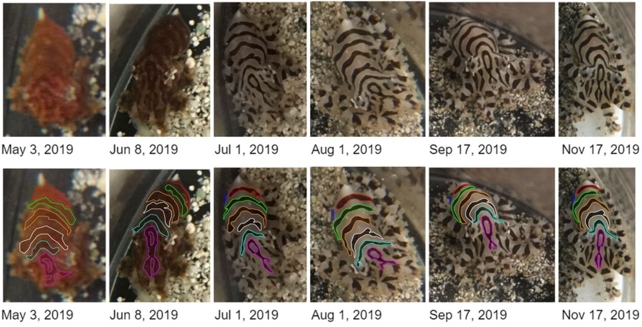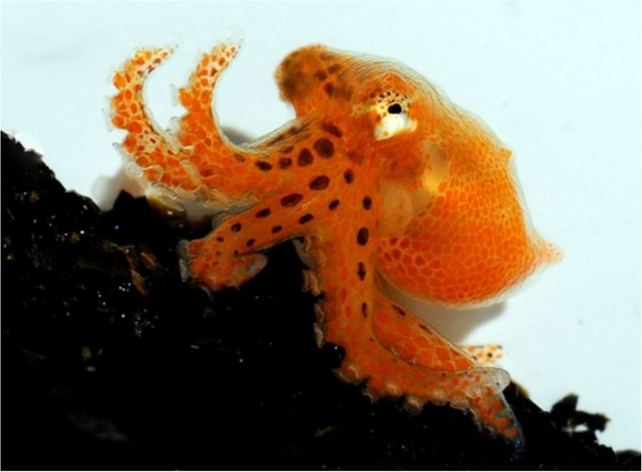Octopuses are the chameleons of the sea, so it's hard to keep tabs on who is who at a glance.
Thanks to small, pigment-filled skin tissues called chromatophores, color-reflecting iridophores, and light-reflecting leucophores, the mollusk can change its patterns and coloring in a blink.
Combined with their hydrostatic skeletons and dexterous muscles shifting their shapes and textures, individual octopuses rarely look the same from moment to moment.
Now a new study has found one octopus species with a base pattern that, like a photographer's watermark, is visible regardless of its dazzling pixel display.
They think this unique 'fingerprint' will help scientists and non-experts monitor the lesser Pacific striped octopus (Octopus chierchiae), also known as the pygmy zebra octopus, in the wild and captivity.

Consisting of a mix of stripes, bars, and spots, each octopus's unique pattern is in its highest contrast at rest. The 'barcode' develops like a Polaroid picture over its first four weeks, though it can appear as early as the first five days of the octopus's life.
Most octopus species only reproduce once before they die, but in the lab, some lesser Pacific striped octopuses laid up to eight egg clutches in their two-year lifetime. This means more octopuses to study and a quick turnaround between generations, making this species a prime candidate for a model organism.
It's worth noting conditions in the lab remain consistent, with octopuses mostly kept separate, free from the rough-and-tumble world of the wild, so it's unclear if environmental conditions or injuries might affect stripe patterns. But in the six years these octopuses have been bred in captivity, the researchers have seen no changes to the patterns on their upper mantle.
Once the researchers knew they could identify each octopus by its stripes, they wanted to know if untrained observers could do the same.

They recruited community observers via their workplace's Slack channel and through Facebook groups unrelated to science or biology.
Octopuses more than four weeks old were chosen to 'model' for the photos used in this study because, by this time, their mantle patterns were clearly visible by sight.
The 38 anonymous observers were sent a quiz in which they viewed 20 slides, each showing two different photos of an octopus side-by-side (with pictures taken up to 25 weeks apart). Nine slides showed two photos of the same octopus; eleven showed pictures of two different octopuses.
For each slide, participants recorded whether they thought they were looking at the same octopus or not.
It turns out these octopus amateurs scored well: 17 respondents had an accuracy of 95 percent or more, with the median score being 90 percent.
Even when they were wrong, respondents were just as likely to incorrectly think they were looking at the same octopus as to incorrectly assume they were looking at two different octopuses.
And they didn't make many of these mistakes: Respondents missed only two true matches on average.
Photo identification is a great way of avoiding all kinds of octopus troubles – and scientific expenses. Scientists usually track cephalopods by tagging them if they're large enough. But these tentacled creatures are notorious for deliberately pulling off tags, and even beyond these uncooperative antics, tags fall off on their own and sometimes damage the octopus's soft tissue.
Tags are not a viable option for smaller animals like the lesser Pacific striped octopus, whose mantle grows to a tiny maximum length of 4 centimeters (about 1.6 inches). While tattooing or branding can work, it's not an easy job trying to mark these miniature escape artists: Usually, the octopus becomes at least distressed or, at worst, injured.
With all these issues, it's appealing to identify an octopus by naturally occurring unique features alone.
Photography is not only a hassle-free option for both scientists and octopuses; it also records data like location, time, behavior, and ecological interactions, offering a wealth of information about the species recorded.
Photos can be added to existing photobanks, and continual technological advances are constantly creating new ways of analyzing large collections of images. Many marine biology projects are beginning to use AI to process their visual datasets.
Before this study, the only octopus known to have markings unique enough for photo ID was the aptly-named Wunderpus photogenicus.
The lesser Pacific striped octopus is a 'harlequin octopus', a name that refers to the dramatic stripes and spots they display, along with the larger Pacific striped octopus and the Atlantic banded octopus (Octopus zonatus). These octopus species may be candidates for similar identification methods.
This research was published in PLOS One.
